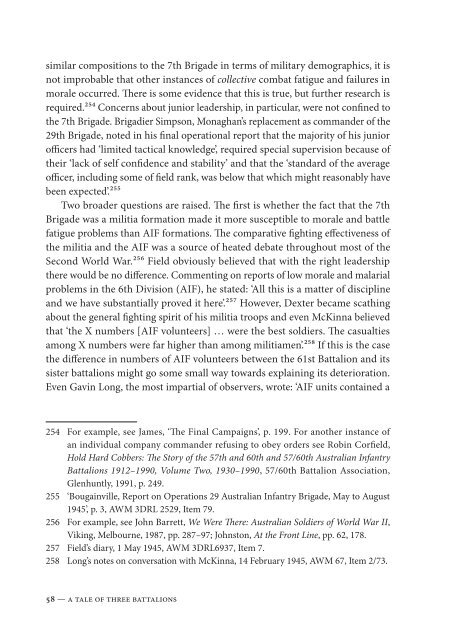View the pdf - Australian Army
View the pdf - Australian Army
View the pdf - Australian Army
You also want an ePaper? Increase the reach of your titles
YUMPU automatically turns print PDFs into web optimized ePapers that Google loves.
similar compositions to <strong>the</strong> 7th Brigade in terms of military demographics, it isnot improbable that o<strong>the</strong>r instances of collective combat fatigue and failures inmorale occurred. There is some evidence that this is true, but fur<strong>the</strong>r research isrequired.254 Concerns about junior leadership, in particular, were not confined to<strong>the</strong> 7th Brigade. Brigadier Simpson, Monaghan’s replacement as commander of <strong>the</strong>29th Brigade, noted in his final operational report that <strong>the</strong> majority of his juniorofficers had ‘limited tactical knowledge’, required special supervision because of<strong>the</strong>ir ‘lack of self confidence and stability’ and that <strong>the</strong> ‘standard of <strong>the</strong> averageofficer, including some of field rank, was below that which might reasonably havebeen expected’.255Two broader questions are raised. The first is whe<strong>the</strong>r <strong>the</strong> fact that <strong>the</strong> 7thBrigade was a militia formation made it more susceptible to morale and battlefatigue problems than AIF formations. The comparative fighting effectiveness of<strong>the</strong> militia and <strong>the</strong> AIF was a source of heated debate throughout most of <strong>the</strong>Second World War.256 Field obviously believed that with <strong>the</strong> right leadership<strong>the</strong>re would be no difference. Commenting on reports of low morale and malarialproblems in <strong>the</strong> 6th Division (AIF), he stated: ‘All this is a matter of disciplineand we have substantially proved it here’.257 However, Dexter became scathingabout <strong>the</strong> general fighting spirit of his militia troops and even McKinna believedthat ‘<strong>the</strong> X numbers [AIF volunteers] … were <strong>the</strong> best soldiers. The casualtiesamong X numbers were far higher than among militiamen’.258 If this is <strong>the</strong> case<strong>the</strong> difference in numbers of AIF volunteers between <strong>the</strong> 61st Battalion and itssister battalions might go some small way towards explaining its deterioration.Even Gavin Long, <strong>the</strong> most impartial of observers, wrote: ‘AIF units contained a254 For example, see James, ‘The Final Campaigns’, p. 199. For ano<strong>the</strong>r instance ofan individual company commander refusing to obey orders see Robin Corfield,Hold Hard Cobbers: The Story of <strong>the</strong> 57th and 60th and 57/60th <strong>Australian</strong> InfantryBattalions 1912–1990, Volume Two, 1930–1990, 57/60th Battalion Association,Glenhuntly, 1991, p. 249.255 ‘Bougainville, Report on Operations 29 <strong>Australian</strong> Infantry Brigade, May to August1945’, p. 3, AWM 3DRL 2529, Item 79.256 For example, see John Barrett, We Were There: <strong>Australian</strong> Soldiers of World War II,Viking, Melbourne, 1987, pp. 287–97; Johnston, At <strong>the</strong> Front Line, pp. 62, 178.257 Field’s diary, 1 May 1945, AWM 3DRL6937, Item 7.258 Long’s notes on conversation with McKinna, 14 February 1945, AWM 67, Item 2/73.58 — A tale of three battalions
















